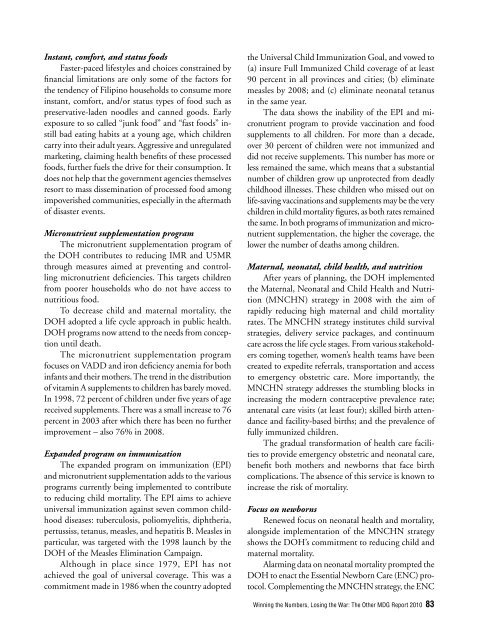Report - Social Watch Philippines
Report - Social Watch Philippines
Report - Social Watch Philippines
You also want an ePaper? Increase the reach of your titles
YUMPU automatically turns print PDFs into web optimized ePapers that Google loves.
Instant, comfort, and status foods<br />
Faster-paced lifestyles and choices constrained by<br />
fi nancial limitations are only some of the factors for<br />
the tendency of Filipino households to consume more<br />
instant, comfort, and/or status types of food such as<br />
preservative-laden noodles and canned goods. Early<br />
exposure to so called “junk food” and “fast foods” instill<br />
bad eating habits at a young age, which children<br />
carry into their adult years. Aggressive and unregulated<br />
marketing, claiming health benefi ts of these processed<br />
foods, further fuels the drive for their consumption. It<br />
does not help that the government agencies themselves<br />
resort to mass dissemination of processed food among<br />
impoverished communities, especially in the aftermath<br />
of disaster events.<br />
Micronutrient supplementation program<br />
The micronutrient supplementation program of<br />
the DOH contributes to reducing IMR and U5MR<br />
through measures aimed at preventing and controlling<br />
micronutrient defi ciencies. This targets children<br />
from poorer households who do not have access to<br />
nutritious food.<br />
To decrease child and maternal mortality, the<br />
DOH adopted a life cycle approach in public health.<br />
DOH programs now attend to the needs from conception<br />
until death.<br />
The micronutrient supplementation program<br />
focuses on VADD and iron defi ciency anemia for both<br />
infants and their mothers. The trend in the distribution<br />
of vitamin A supplements to children has barely moved.<br />
In 1998, 72 percent of children under fi ve years of age<br />
received supplements. There was a small increase to 76<br />
percent in 2003 after which there has been no further<br />
improvement – also 76% in 2008.<br />
Expanded program on immunization<br />
The expanded program on immunization (EPI)<br />
and micronutrient supplementation adds to the various<br />
programs currently being implemented to contribute<br />
to reducing child mortality. The EPI aims to achieve<br />
universal immunization against seven common childhood<br />
diseases: tuberculosis, poliomyelitis, diphtheria,<br />
pertussiss, tetanus, measles, and hepatitis B. Measles in<br />
particular, was targeted with the 1998 launch by the<br />
DOH of the Measles Elimination Campaign.<br />
Although in place since 1979, EPI has not<br />
achieved the goal of universal coverage. This was a<br />
commitment made in 1986 when the country adopted<br />
the Universal Child Immunization Goal, and vowed to<br />
(a) insure Full Immunized Child coverage of at least<br />
90 percent in all provinces and cities; (b) eliminate<br />
measles by 2008; and (c) eliminate neonatal tetanus<br />
in the same year.<br />
The data shows the inability of the EPI and micronutrient<br />
program to provide vaccination and food<br />
supplements to all children. For more than a decade,<br />
over 30 percent of children were not immunized and<br />
did not receive supplements. This number has more or<br />
less remained the same, which means that a substantial<br />
number of children grow up unprotected from deadly<br />
childhood illnesses. These children who missed out on<br />
life-saving vaccinations and supplements may be the very<br />
children in child mortality fi gures, as both rates remained<br />
the same. In both programs of immunization and micronutrient<br />
supplementation, the higher the coverage, the<br />
lower the number of deaths among children.<br />
Maternal, neonatal, child health, and nutrition<br />
After years of planning, the DOH implemented<br />
the Maternal, Neonatal and Child Health and Nutrition<br />
(MNCHN) strategy in 2008 with the aim of<br />
rapidly reducing high maternal and child mortality<br />
rates. The MNCHN strategy institutes child survival<br />
strategies, delivery service packages, and continuum<br />
care across the life cycle stages. From various stakeholders<br />
coming together, women’s health teams have been<br />
created to expedite referrals, transportation and access<br />
to emergency obstetric care. More importantly, the<br />
MNCHN strategy addresses the stumbling blocks in<br />
increasing the modern contraceptive prevalence rate;<br />
antenatal care visits (at least four); skilled birth attendance<br />
and facility-based births; and the prevalence of<br />
fully immunized children.<br />
The gradual transformation of health care facilities<br />
to provide emergency obstetric and neonatal care,<br />
benefi t both mothers and newborns that face birth<br />
complications. The absence of this service is known to<br />
increase the risk of mortality.<br />
Focus on newborns<br />
Renewed focus on neonatal health and mortality,<br />
alongside implementation of the MNCHN strategy<br />
shows the DOH’s commitment to reducing child and<br />
maternal mortality.<br />
Alarming data on neonatal mortality prompted the<br />
DOH to enact the Essential Newborn Care (ENC) protocol.<br />
Complementing the MNCHN strategy, the ENC<br />
Winning the Numbers, Losing the War: The Other MDG <strong>Report</strong> 2010 83


